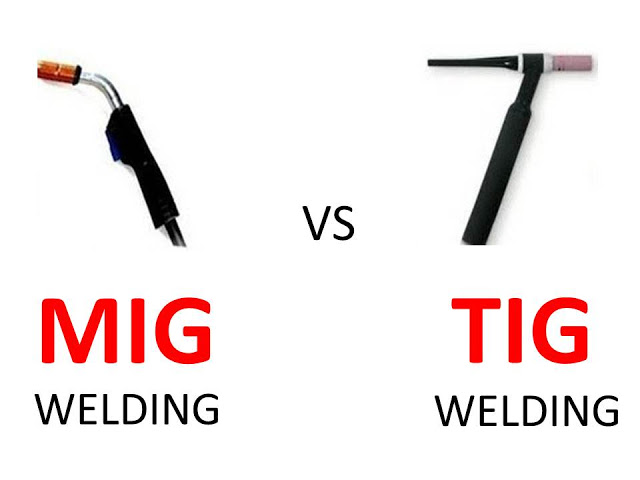The Components Of Mig Welding Machine Vs. Tig Welding Machine
A major difference between these two forms of arc welding is the equipment used. Since they both approach welding with different methods, the equipment must be different to accommodate these changes. The next sections will show you the different components used between TIG and MIG welding.

TIG WELD COMPONENTS
Here are the defining components of TIG welding:
- Power: The source can be AC or DC. Some welders will have a switch to choose a preferred electrical current. An AC power source will work better with metal like aluminum. A DC power source will give a strong arc, but the workpiece should be cleaned beforehand so the gas shield works.
- Torch: A TIG torch can have a wide variety of designs. Some might have the on/off switch and control in the handle, or a foot pedal could control these commands.
- Foot pedal: This controls the electricity that goes to the torch. When you push harder on the pedal, the amount of electricity is increased and makes the arc hotter. This speeds up the welding process, but you need to be aware of how to handle the extra heat and speed.
- Electrode and gas shielding: The electrode tip angle shapes the arc that makes the weld pool. In between welding, you need to make sure it’s in good condition. The torch nozzle needs a gas lens for gas flow to protect the arc and weld pool. Nozzles come in different sizes to get varying gas coverage. The gas is usually Argon.
- Filler material: Filler rods come in many materials and sizes. The rod should match the material you’re welding and the material’s thickness determines the size of the filler rod.
- Backing bars: These help cool the weld area faster than if you’d let it cool down on its own. You clamp backing bars to the back of the welded piece. A backing bar can be made of either copper or aluminum to disperse heat. Water-cooled backing bars are also available, in which cold water circulates through the bar to speed up the cooling process.
MIG WELD COMPONENTS
MIG welding and TIG welding use different equipment to achieve similar goals. The following list describes MIG welding’s components:
- Power: The source is usually DC with a constant voltage.
- Wire: The wire-feed system has to run smoothly so your welding will be even. Feeding systems include pinch rolls, push-pull and spool-on-gun.
- Electrode: Depending on your project, you’ll need to get the right diameter and composition for your MIG weld.
- Torch: The welding torch provides gas that protects the arc and weld pool and transfers the welding current to the wire. Torches can be air-cooled or water-cooled. Air-cooled torches are typically cheaper and lighter than water-cooled torches. They use the gas going through to cool the nozzle. They’re suited for lighter welding projects. Water-cooled guns are preferred when a welder is using a high current and doing heavy-duty work.
- Conduit: Keep the conduit short and straight so feeding can happen without issue.
- Filler metal: It conducts electrical current to melt the electrode but also reinforces what you’ve welded.
- Gas shielding: The gas that protects the weld pool and arc is usually made up of Argon and Carbon Dioxide
.
Why Choose PerfectPower for Your Welding Needs?
At PerfectPower Welding Machine & Manufacturing, we are a full-service job shop and repair company specializing in manufacturing large assemblies and subassemblies in prototype to full production quantities. In addition to our machining and grinding capabilities, our secondary services range from fabrication and welding to complete repair, replacement, and reassembly.
Our fully certified welders are well-versed in MIG and TIG welding and accommodate aluminum, carbon steel, and stainless steel materials. Some of the typical products we assemble and repair.
To learn more about our welding capabilities, contact us or request a quote today.


